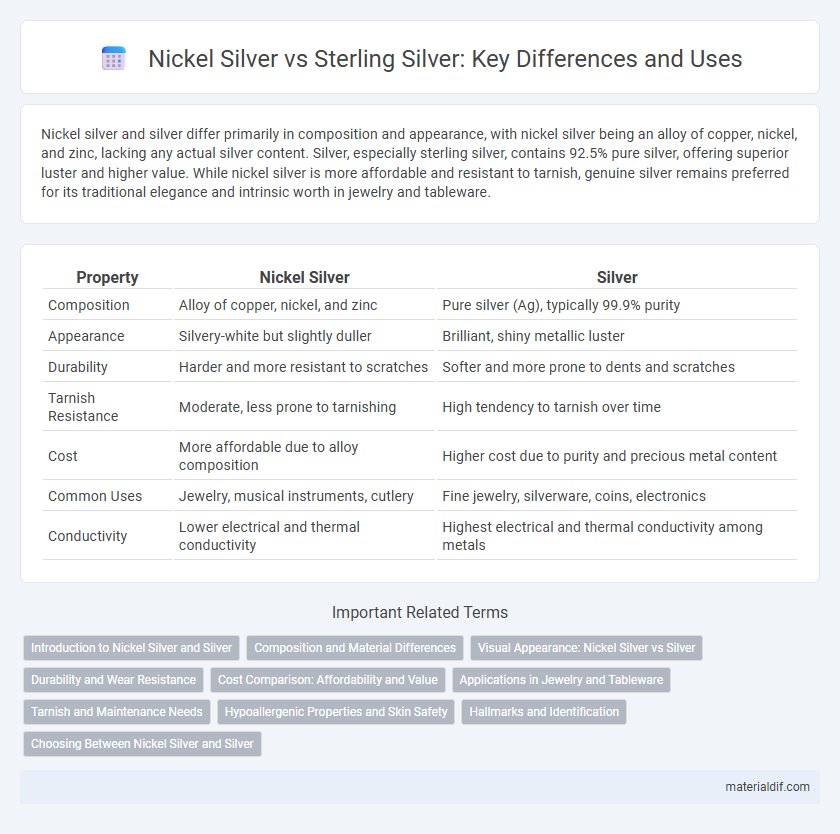Nickel silver and silver differ primarily in composition and appearance, with nickel silver being an alloy of copper, nickel, and zinc, lacking any actual silver content. Silver, especially sterling silver, contains 92.5% pure silver, offering superior luster and higher value. While nickel silver is more affordable and resistant to tarnish, genuine silver remains preferred for its traditional elegance and intrinsic worth in jewelry and tableware.
Table of Comparison
| Property | Nickel Silver | Silver |
|---|---|---|
| Composition | Alloy of copper, nickel, and zinc | Pure silver (Ag), typically 99.9% purity |
| Appearance | Silvery-white but slightly duller | Brilliant, shiny metallic luster |
| Durability | Harder and more resistant to scratches | Softer and more prone to dents and scratches |
| Tarnish Resistance | Moderate, less prone to tarnishing | High tendency to tarnish over time |
| Cost | More affordable due to alloy composition | Higher cost due to purity and precious metal content |
| Common Uses | Jewelry, musical instruments, cutlery | Fine jewelry, silverware, coins, electronics |
| Conductivity | Lower electrical and thermal conductivity | Highest electrical and thermal conductivity among metals |
Introduction to Nickel Silver and Silver
Nickel silver, also known as German silver, is an alloy composed primarily of copper, nickel, and zinc, designed to mimic the appearance of silver without containing any actual silver content. In contrast, silver is a precious metal prized for its high conductivity, luster, and intrinsic value, commonly used in jewelry, electronics, and currency. While nickel silver offers durability and corrosion resistance at a lower cost, genuine silver retains superior malleability, antibacterial properties, and investment significance.
Composition and Material Differences
Nickel silver is an alloy primarily composed of copper, nickel, and zinc, lacking any actual silver content, which distinguishes it from pure silver made of at least 92.5% silver in sterling varieties. The metallic properties of nickel silver result in a harder, more durable material with a silvery appearance, while pure silver is softer, more malleable, and highly valued for its luster and conductivity. These compositional differences influence their applications, with nickel silver commonly used in decorative items and cutlery, whereas silver is preferred for fine jewelry and high-end electronic components.
Visual Appearance: Nickel Silver vs Silver
Nickel silver displays a muted grayish tone with a slightly yellowish tint, lacking the bright luster and radiant whiteness characteristic of pure silver. Silver offers a highly reflective, brilliant white surface that enhances its appeal in jewelry and decorative items. Over time, silver develops a distinctive patina and tarnish, while nickel silver tends to retain a more consistent dull shine without darkening as quickly.
Durability and Wear Resistance
Nickel silver, an alloy composed primarily of copper, nickel, and zinc, offers superior durability and wear resistance compared to pure silver, making it ideal for everyday items subjected to frequent contact and abrasion. Pure silver, while prized for its luster and malleability, is softer and more prone to scratching and tarnishing over time. The hardness of nickel silver enhances its structural integrity and longevity, especially in applications like jewelry and cutlery where resistance to wear is critical.
Cost Comparison: Affordability and Value
Nickel silver offers greater affordability compared to pure silver, making it a cost-effective choice for budget-conscious consumers. While silver boasts higher intrinsic value due to its precious metal content, nickel silver provides durability and a similar aesthetic at a fraction of the price. Choosing nickel silver balances cost savings with visual appeal, whereas investing in pure silver prioritizes long-term value and investment potential.
Applications in Jewelry and Tableware
Nickel silver, an alloy of copper, nickel, and zinc, offers durability and corrosion resistance, making it popular for affordable jewelry and tableware that mimic the appearance of real silver. Sterling silver, composed of 92.5% pure silver, is favored for high-end jewelry and premium tableware due to its luster, hypoallergenic properties, and value retention. While nickel silver provides budget-friendly options with tarnish resistance, sterling silver remains the standard for luxury and heirloom-quality pieces.
Tarnish and Maintenance Needs
Nickel silver, an alloy composed mainly of copper, nickel, and zinc, resists tarnish better than pure silver due to its lack of actual silver content, making it easier to maintain with minimal cleaning. Pure silver, especially sterling silver (92.5% silver), oxidizes over time and develops a tarnish that requires regular polishing and careful storage to preserve its luster. While nickel silver offers durability and low maintenance, it lacks the authentic silver value and patina appreciated by collectors and silver enthusiasts.
Hypoallergenic Properties and Skin Safety
Nickel silver, an alloy containing copper, nickel, and zinc, often causes allergic reactions due to its nickel content, making it less suitable for sensitive skin. Pure silver, especially sterling silver (92.5% silver), is hypoallergenic and safer for individuals prone to skin irritation or metal allergies. Choosing genuine silver jewelry reduces the risk of dermatitis compared to nickel silver alternatives.
Hallmarks and Identification
Nickel silver, often marked with hallmarks like "NS" or "nickel," lacks the precious metal content found in true silver, which is typically stamped with "925" or "Sterling" indicating 92.5% purity. Identifying silver involves checking for specific assay marks, numbers, or symbols denoting its authenticity and quality, whereas nickel silver may have manufacturer marks but no purity stamps. Hallmarks on genuine silver are regulated and standardized, making them a reliable indicator, while nickel silver's marks can vary widely and do not guarantee silver content.
Choosing Between Nickel Silver and Silver
Nickel silver offers greater durability and corrosion resistance compared to pure silver, making it ideal for items requiring strength and longevity. Silver, prized for its high conductivity and elegant luster, remains the choice for fine jewelry and high-end tableware despite being softer and prone to tarnish. When choosing between nickel silver and silver, consider the application's demand for durability versus aesthetic appeal and value.
Nickel Silver vs Silver Infographic

 materialdif.com
materialdif.com